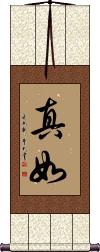Many custom options...
And formats...

Tathata in Chinese / Japanese...
Buy a Tathata calligraphy wall scroll here!
Tathata / Ultimate Nature of All Things
真如 comes from the Sanskrit and Pali word often romanized as “tathata” or “tathatā.” Originally written, “तथता.”
It's a Buddhist term often translated as “thusness” or “suchness,” but this does not explain it.
A better explanation may be “the ultimate nature of all things” or “ultimate truth.” However, this gives it too strong of a feeling. This concept is sometimes described as being in awe of the simple nature of something - like a blade of grass blowing in the wind or ripples on water. It is what it is supposed to be, these things follow their nature. Amazing in their mundane simplicity.
Every sect of Buddhism will have a slightly different flavor or explanation, so don't get fixated on one definition.
Notes: Sometimes Buddhists use the word dharmatā, a synonym to tathatā.
In Japan, this can also be the female given name Mayuki, or the surname Majo.
Not the results for tathata that you were looking for?
Below are some entries from our dictionary that may match your tathata search...
| Characters If shown, 2nd row is Simp. Chinese |
Pronunciation Romanization |
Simple Dictionary Definition |
真如 see styles |
zhēn rú zhen1 ru2 chen ju mayuki まゆき |
More info & calligraphy: Tathata / Ultimate Nature of All Things{Buddh} tathata (the ultimate nature of all things); (female given name) Mayuki |
如 see styles |
rú ru2 ju yuki ゆき |
as; as if; such as {Buddh} (See 真如) tathata (the ultimate nature of all things); (female given name) Yuki tathā 多陀; 但他 (or 怛他), so, thus, in such manner, like, as. It is used in the sense of the absolute, the 空 śūnya, which is 諸佛之實相 the reality of all Buddhas; hence 如 ru is 賃相 the undifferentiated whole of things, the ultimate reality; it is 諸法之性 the nature of all things, hence it connotes 法性 faxing which is 眞實之際極 the ultimate of reality, or the absolute, and therefore connotes 實際 ultimate reality. The ultimate nature of all things being 如 ru, the one undivided same, it also connotes 理 li, the principle or theory behind all things, and this 理 li universal law, being the 眞實 truth or ultimate reality; 如 ru is termed 眞如 bhūtatathatā, the real so, or suchness, or reality, the ultimate or the all, i. e. the 一如 yiru. In regard to 如 ju as 理 li the Prajñā-pāramitā puṇḍarīka makes it the 中 zhong, neither matter nor nothingness. It is also used in the ordinary sense of so, like, as (cf yathā). |
性海 see styles |
xìng hǎi xing4 hai3 hsing hai shoukai / shokai しょうかい |
{Buddh} world of tathata; the pure and absolute truth of the tathata is as wide as the sea; (surname, given name) Shoukai The ocean of the bhūtatathatā, the all-containing, immaterial nature of the dharmakāya. |
眞如 see styles |
zhēn rú zhen1 ru2 chen ju shinnyo しんにょ |
(surname) Shinnyo bhūtatathatā, 部多多他多. The眞 is intp. as 眞實 the real, 如 as 如常 thus always or eternally so; i.e. reality as contrasted with 虛妄 unreality, or appearance, and 不變不改 unchanging or immutable as contrasted with form and phenomena. It resembles the ocean in contrast with the waves. It is the eternal, impersonal, unchangeable reality behind all phenomena. bhūta is substance, that which exists; tathatā is suchness, thusness, i.e. such is its nature. The word is fundamental to Mahāyāna philosophy, implying the absolute, the ultimate source and character of all phenomena, it is the All. It is also called 自性淸淨心 self-existent pure Mind; 佛性 Buddha-nature; 法身 dharmakāya; 如來藏 tathāgata-garbha, or Buddha-treasury; 實相 reality; 法界 Dharma-realm; 法性Dharma-nature; 圓成實性 The complete and perfect real nature, or reality. There are categories of 1, 2, 3, 7, 10, and 12 in number: (1) The undifferentiated whole. (2) There are several antithetical classes, e.g. the unconditioned and the conditioned; the 空 void, static, abstract, noumenal, and the 不 空 not-void, dynamic, phenomenal; pure, and affected (or infected); undefiled (or innocent), i.e. that of Buddhas, defiled, that of all beings; in bonds and free; inexpressible, and expressible in words. (3) 無相 Formless; 無生 uncreated; 無性 without nature, i.e. without characteristics or qualities, absolute in itself. Also, as relative, i.e. good, bad, and indeterminate. (7, 10, 12) The 7 are given in the 唯識論 8; the 10 are in two classes, one of the 別教 cf. 唯識論 8; the other of the 圓教, cf. 菩提心義 4; the 12 are given in the Nirvana Sutra. |
七如眞 see styles |
qī rú zhēn qi1 ru2 zhen1 ch`i ju chen chi ju chen |
The seven aspects of the bhūta-tathatā , v. 如眞 One list is 流轉如眞 實相如眞, 唯識如眞, 安立如眞, 邪行如眞, 淸淨如眞, 正行如眞. From the 唯識論 8. |
眞如常住 see styles |
zhēn rú cháng zhù zhen1 ru2 chang2 zhu4 chen ju ch`ang chu chen ju chang chu shinnyo jōjū |
eternal dwelling of the truth (tathatā) |
眞如性起 see styles |
zhēn rú xìng qǐ zhen1 ru2 xing4 qi3 chen ju hsing ch`i chen ju hsing chi shinnyo shōki |
the arising of all phenomena dependent upon or due to tathatā |
The following table may be helpful for those studying Chinese or Japanese...
| Title | Characters | Romaji (Romanized Japanese) | Various forms of Romanized Chinese | |
| Tathata Ultimate Nature of All Things | 真如 | shinnyo | zhēn rú / zhen1 ru2 / zhen ru / zhenru | chen ju / chenju |
Successful Chinese Character and Japanese Kanji calligraphy searches within the last few hours...




